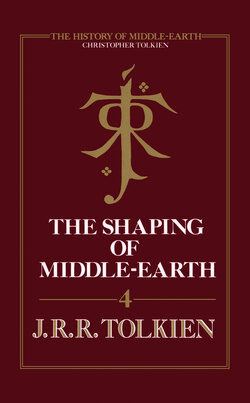Читать книгу The Shaping of Middle-earth - Christopher Tolkien - Страница 6
ОглавлениеPREFACE
This book brings the ‘History of Middle-earth’ to some time in the 1930s: the cosmographical work Ambarkanta and the earliest Annals of Valinor and Annals of Beleriand, while later than the Quenta Noldorinwa – the ‘Silmarillion’ version that was written, as I believe, in 1930 – cannot themselves be more precisely dated.
This is the stage at which my father had arrived when The Hobbit was written. Comparison of the Quenta with the published Silmarillion will show that the essential character of the work was now fully in being; in the shape and fall of sentences, even of whole passages, the one is constantly echoed in the other; and yet the published Silmarillion is between three and four times as long.
After the hasty ‘Sketch of the Mythology’ (chapter II in this book), the Quenta Noldorinwa was in fact the only complete version of ‘The Silmarillion’ that my father ever made. Towards the end of 1937 he interrupted work on a new version, Quenta Silmarillion, which extended to part way through the story of Túrin Turambar, and began The Lord of the Rings (see The Lays of Beleriand pp. 364–7). When after many years he returned to the First Age, the vast extension of the world that had now come into being meant that the Quenta Silmarillion, which had been stopped in full flight, could not be taken up from where it fell; and though he undertook exceedingly complex revisions and enlargements of the earlier parts during the following years, he never achieved again a complete and coherent structure. Especially in its concluding chapters the Quenta Noldorinwa is thus one of the primary elements in the study of the work as a whole.
In the Annals of Valinor and the Annals of Beleriand are seen the beginnings of the chronological structure which was to become a central preoccupation. The Annals would develop into a separate ‘tradition’, parallel to and overlapping but distinct from ‘The Silmarillion’ proper, and (after intervening versions) emerging in the years following the completion of The Lord of the Rings in two chief works of the Matter of Middle-earth, the Annals of Aman and the Grey Annals of Beleriand (see pp. 262, 294). With the Quenta and with these earliest versions of the Annals I give the brief texts in Anglo-Saxon feigned to have been made by Ælfwine (Eriol) from the works that he studied in Tol Eressëa, the Lonely Isle.
The commentaries are largely concerned to relate geography, names, events, relationships and motives to what preceded and what followed; inevitably this entails a great deal of reference back to the previous books, and the text of the commentaries is hardly enticing (though being in smaller print they can be readily distinguished from the original works). My object is to try to show, and not merely impressionistically, how Middle-earth and its history was built up gradually and delicately, and how a long series of small shifts or combinations would often lead to the emergence of new and unforeseen structures – as for example in the story of Gwindor of Nargothrond (p. 180).
The arrangement of the texts of the ‘Sketch of the Mythology’ and the Quenta, split into numbered sections comparable from one text to the other, is explained on p. 11. The earlier volumes in the series are referred to as I (The Book of Lost Tales Part I), II (The Book of Lost Tales Part II), and III (The Lays of Beleriand).
The maps and diagrams in the book are reproduced with the permission of the Bodleian Library, Oxford, and I thank the staff of the Department of Western Manuscripts at the Bodleian for their assistance.
The fifth volume will contain my father’s unfinished ‘time-travel’ story, The Lost Road, together with the earliest forms of the legend of Númenor, which were closely related to it; the Lhammas or Account of Tongues; the Etymologies; and all the writings concerned with the First Age up to the time when The Lord of the Rings was begun.
